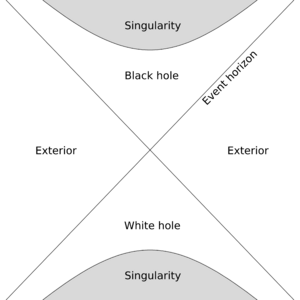White hole facts for kids
Think of a white hole as a theoretical idea. It's a special area in space and time that nothing can enter. It's like a one-way door, but instead of letting things in, it only lets things out!
Here's a simple way to understand it:
- Black Hole: A region in space where gravity is super strong. Nothing, not even light, can escape once it crosses the "event horizon." This is the point of no return.
- White Hole: A region in space that nothing can enter. It has an event horizon that only allows things to exit. Nothing can go in.
Contents
The Science Behind White Holes
The idea of white holes comes from Albert Einstein's theory of general relativity. This theory explains gravity as a curve in space and time. This curve is caused by mass and energy. When scientists solved Einstein's equations, they found solutions that described both black holes and white holes.
The most famous solution is called the Schwarzschild metric. It was named after Karl Schwarzschild, who found it in 1916. This was just a year after Einstein shared his theory. This solution describes a black hole that is perfectly round and doesn't spin. The same math can also describe a white hole!
What About Wormholes?
This is where things get really interesting. Some scientists think that black holes and white holes might be connected. They might be linked by something called a wormhole. This is also known as an Einstein-Rosen bridge.
Imagine folding a piece of paper in half. Draw a dot on each side. A wormhole would be like poking a hole through the paper. This hole would connect the two dots. In space, a wormhole would be a tunnel. It could connect a black hole to a white hole. This might let matter and light travel from one part of the universe to another. It could even lead to another universe!
However, wormholes are also just a theory. Even if they exist, they might be too unstable. Or they might be too small for anything to travel through.
What White Holes Might Be Like
We haven't found a real white hole yet. So, we can only guess what they might be like. Our guesses are based on math and theories. Here are some things they might have:
- Event horizon: Just like black holes, white holes would have an event horizon. But for a white hole, it would be a point of no return out of the hole. Nothing could get back in.
- Singularity: At the center of a white hole, there might be a singularity. This is a point where the density and gravity are endless. This is similar to the singularity at the center of a black hole.
- Shooting out stuff: White holes would constantly be shooting out matter and energy. This would go into the universe. This could be light, tiny particles, or even bigger objects.
Why Are White Holes So Hard to Find?
If white holes are real, why haven't we found any? There are a few possible reasons:
- They might not exist: The simplest answer is that white holes are just a math idea. They might not actually exist in our universe. The conditions needed to form a white hole might be too extreme. They might never happen naturally.
- They are unstable: White holes might be very unstable. As soon as they form, they might collapse into something else. They could turn into a black hole.
- They are hidden: White holes might be hidden. They could be behind something else. This could be a black hole or a thick cloud of gas and dust. This would make them very hard to spot.
- They look like something else: The way white holes shoot out matter and energy might make them look like other things. They could look like quasars or supernovas. We might have already seen white holes without knowing it!
Cool Facts About White Holes
- The idea of a white hole was first suggested by a Russian scientist named Igor Novikov in 1964.
- A paper from 2012 suggests that the Big Bang itself might have been a white hole.
- Some theories suggest that white holes could possibly be used for time travel. However, this is just a guess and probably not possible.
- The theories about white holes have not been proven yet.
- Right now, very few scientists believe white holes exist. It is mostly seen as a math exercise.
Related Pages
See also
 In Spanish: Agujero blanco para niños
In Spanish: Agujero blanco para niños



